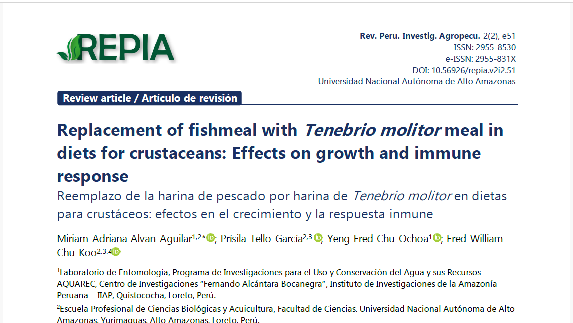Substituição da farinha de peixe pela farinha de Tenebrio molitor em dietas de crustáceos: efeitos no crescimento e na resposta imune
DOI:
https://doi.org/10.56926/repia.v2i2.51Palavras-chave:
aquicultura, alimentando, insetos, crustáceos, saúdeResumo
A utilização da farinha de peixe (FM) como fonte proteica na aquicultura é uma das principais críticas desta indústria. Aumentar a produção de forma mais sustentável é um imperativo atual para este setor. Por outro lado, a criação de insetos tornou-se uma alternativa promissora para alimentação da aquicultura, uma vez que diversas espécies podem ser produzidas a partir de resíduos orgânicos. Os insetos são organismos ricos em nutrientes, de alta energia e com um perfil equilibrado de aminoácidos, ao contrário das fontes de proteínas vegetais que são deficientes em certos aminoácidos essenciais. O objetivo do manuscrito é apresentar uma revisão de pesquisas recentes sobre a substituição da FM pela farinha larval de Tenebrio molitor (TMM), besouro que se popularizou como alternativa em dietas de aquicultura, e seus efeitos no crescimento e na reprodução. em crustáceos. Estudos indicam que o MMT pode substituir completamente o FM em Litopenaeus vannamei, enquanto os níveis de substituição que funcionaram melhor para Macrobrachium rosenbergii e lagostins variam de 12 a 50%. Não foram encontrados estudos em crustáceos amazônicos ou sul-americanos, o que abre oportunidades para novas linhas de pesquisa.
Downloads
Referências
Choi, I. H.; Kim, J. M.; Kim, N. J.; Kim, J. D.; Park, C.; Park, J. H.; & Chung, T. H. (2018). Replacing fish meal by mealworm (Tenebrio molitor) on the growth performance and immunologic responses of white shrimp (Litopenaeus vannamei). Acta Scientiarum - Animal Sciences, 40, 1–9. https://doi.org/10.4025/actascianimsci.v40i1.39077
Costa-Pierce, B.A.; & Chopin, T. (2021). The hype, fantasies, and realities of aquaculture development globally and its new geographies. World Aquaculture Magazine, 52: 23-35.
Dawood, M.A. (2021). Nutritional immunity of fish intestines: important insights for sustainable aquaculture. Reviews in Aquaculture, 13(1):642e63. https://doi.org/10.1111/raq.12492.
Feng, P.; He, J.; Huang, G.; Chen, X.; Yang, Q.; Wang, J.; Wang, D.; & Ma, H. (2019). Effect of dietary Tenebrio molitor protein on growth performance and immunological parameters in Macrobrachium rosenbergii. Aquaculture, 511, 734247. https://doi.org/10.1016/j.aquaculture.2019.734247
Food and Agriculture Organization of the United Nations – FAO (2021). Fishery and Aquaculture Statistics. Global aquaculture production 1950-2019 (FishstatJ). FAO, Rome, Italy. Available at: www.fao.org/fishery/statistics/software/fishstatj/en
Gasco, L.; Henry, M.; Piccolo, G.; Marono, S.; Gai, F.; Renna, M.; Lussiana, C.; Antonopoulou, E.; Mola, P.; & Chatzifotis, S. (2016). Tenebrio molitor meal in diets for European sea bass (Dicentrarchus labrax L.) juveniles: Growth performance, whole body composition and in vivo apparent digestibility. Animal Feed Science and Technology, 220, 34–45. https://doi.org/10.1016/j.anifeedsci.2016.07.003
Gu, J., Liang, H., Ge, X., Xia, D., Pan, L., Mi, H., & Ren, M. (2022). A study of the potential effect of yellow mealworm (Tenebrio molitor) substitution for fish meal on growth, immune and antioxidant capacity in juvenile largemouth bass (Micropterus salmoides). Fish and Shellfish Immunology, 120(October 2021), 214–221. https://doi.org/10.1016/j.fsi.2021.11.024
Henry, M.A.; Gai, F.; Enes, P.; Pérez-Jiménez, A.; & Gasco, L. (2018). Effect of partial dietary replacement of fishmeal by yellow mealworm (Tenebrio molitor) larvae meal on the innate immune response and intestinal antioxidant enzymes of rainbow trout (Oncorhynchus mykiss). Fish and Shellfish Immunology, 8: 83:30. 8e13. https://doi.org/10.1016/j.fsi.2018.09.040.
Hoffmann, L.; Rawski, M.; Nogales-Mérida, S.; Kołodziejski, P.; Pruszyńska-Oszmałek, E.; & Mazurkiewicz, J. (2021). Mealworm meal use in sea trout (Salmo trutta m. trutta, L.) fingerling diets: effects on growth performance, histomorphology of the gastrointestinal tract and blood parameters. Aquaculture Nutrition, 27(5), 1512–1528. https://doi.org/10.1111/anu.13293
Iaconisi, V.; Bonelli, A.; Pupino, R.; Gai, F.; & Parisi, G. (2018). Mealworm as dietary protein source for rainbow trout: Body and fillet quality traits. Aquaculture, 484: 197–204. https://doi.org/10.1016/j.aquaculture.2017.11.034
Iaconisi, V.; Marono, S.; Parisi, G.; Gasco, L.; Genovese, L.; Maricchiolo, G.; Bovera, F.; & Piccolo, G. (2017). Dietary inclusion of Tenebrio molitor larvae meal: Effects on growth performance and final quality treats of blackspot sea bream (Pagellus bogaraveo). Aquaculture, 476: 49–58. https://doi.org/10.1016/j.aquaculture.2017.04.007
Ido, A.; Hashizume, A.; Ohta, T.; Takahashi, T.; Miura, C.; & Miura, T. (2019). Replacement of fish meal by defatted yellow mealworm (Tenebrio molitor) larvae in the diet improves growth performance and disease resistance in red seabream (Pargus major). Animals, 9(3):100. https://doi.org/10.3390/ani9030100.
Jeong, S. M.; Khosravi, S.; Mauliasari, I. R.; & Lee, S. M. (2020). Dietary inclusion of mealworm (Tenebrio molitor) meal as an alternative protein source in practical diets for rainbow trout (Oncorhynchus mykiss) fry. Fisheries and Aquatic Sciences, 23(1): 214–221. https://doi.org/10.1186/s41240-020-00158-7
Li, X.Y.; Chen, Y.K.; Zheng, C.Z.; Chi, S.Y.; Zhang, S.; Tan, B.P.; & Xie, S.W. (2022). Evaluation of six novel protein sources on apparent digestibility in Pacific White Shrimp, Litopenaeus vannamei. Aquaculture Nutrition. https://doi.org/10.1155/2022/8225273.
Makkar, H.P.S.; Tran, G.; Heuzé, V.; & Ankers, P. (2014). State-of-the-art on use of insects as animal feed. Animal Feed Science and Technology, 197: 1-33. https://doi.org/10.1016/j.anifeedsci.2014.07.008
Mastoraki, M.; Vlahos, N.; Patsea, E.; Chatzifotis, S.; Mente, E.; & Antonopoulou, E. (2020). The effect of insect meal as a feed ingredient on survival, growth, and metabolic and antioxidant response of juvenile prawn Palaemon adspersus (Rathke, 1837). Aquaculture Research, 51: 3551-3562. https://doi.org/10.1111/are.14692
Mazlum, Y.; Turan, F.; & Bircan, Y. (2021). Evaluation of mealworms (Tenebrio molitor) meal as an alternative protein source for narrow-clawed crayfish (Pontastacus leptodactylus) juveniles. Aquaculture Research. 1–9. https://doi.org/10.1111/are.15253
Melenchón, F.; Larrán, A. M.; de Mercado, E.; Hidalgo, M. C.; Cardenete, G.; Barroso, F. G.; Fabrikov, D.; Lourenço, H. M.; Pessoa, M. F.; & Tomás-Almenar, C. (2021). Potential use of black soldier fly (Hermetia illucens) and mealworm (Tenebrio molitor) insectmeals in diets for rainbow trout (Oncorhynchus mykiss). Aquaculture Nutrition, 27(2): 491–505. https://doi.org/10.1111/ANU.13201
Naylor, R.L.; Hardy, R.W.; Buschmann, A.H.; Bush, S.R.; Cao, L.; Klinger, D.H.; Little, D.C.; Lubchenco, J.; Shumway, S.E.; & Troell, M. (2021). A 20-year retrospective review of global aquaculture. Nature, 591: 551-563. https://doi.org/10.1038/s41586-021-03308-6
Panini, R. L.; Freitas, L. E. L.; Guimarães, A. M.; Rios, C.; da Silva, M. F. O.; Vieira, F. N.; Fracalossi, D. M.; Samuels, R. I.; Prudêncio, E. S.; Silva, C. P.; & Amboni, R. D. M. C. (2017). Potential use of mealworms as an alternative protein source for Pacific white shrimp: Digestibility and performance. Aquaculture, 473: 115–120. https://doi.org/10.1016/j.aquaculture.2017.02.008
Rema, P.; Saravanan, S.; Armenjon, B.; Motte, C.; & Dias, J. (2019). Graded incorporation of defatted yellow mealworm (Tenebrio molitor) in rainbow trout (Oncorhynchus mykiss) diet improves growth performance and nutrient retention. Animals, 9(4). https://doi.org/10.3390/ani9040187
Ríos, C.; Panini, R.L.; Acordi Menezes, L.A.; Vieira, F.N.; Fracalossi, D.M.; Samuels, R.I.; De Dea Lindner, J.; & Silva, C.P. (2021). Effects of the substitution of fishmeal with mealworm meal on enzymes, haemolymph and intestinal microbiota of the Pacific white shrimp. Journal of Insects as Food and Feed, 7(6): 1023–1033. https://doi.org/10.3920/JIFF2020.0148
Roncarati, A.; Gasco, L.; Parisi, G.; & Terova, A. (2015). Growth performance of common catchfish (Ameiurus melas Raf.) fingerlings fed mealworm (Tenebrio molitor) diet. Journal of Insects as Food and Feed, 1(3): 233 - 240. https://doi.org/10.3920/JIFF2014.0006
Röthig, T.; Vilcinskas, A.; Barth, A.; Tschirner, M.; Schubert, P.; Wenning, M.; Billion, A.; & Wilke, T. (2023). Insect feed in sustainable crustacean aquaculture. Journal of Insects as Food and Feed, 9(9): 1115-1138. https://doi.org/10.3920/JIFF2022.0117
Sankian, Z.; Khosravi, S.; Kim, Y. O.; & Lee, S. M. (2018). Effects of dietary inclusion of yellow mealworm (Tenebrio molitor) meal on growth performance, feed utilization, body composition, plasma biochemical indices, selected immune parameters and antioxidant enzyme activities of mandarin fish (Siniperca scherze). Aquaculture, 496: 79–87. https://doi.org/10.1016/j.aquaculture.2018.07.012
Shafique, L.; Abdel-Latif, H.M.R.; Hassan, F.-u.; Alagawany, M.; Naiel, M.A.E.; Dawood, M.A.O.; Yilmaz, S.; & Liu, Q. (2021). The feasibility of using Yellow Mealworms (Tenebrio molitor): Towards a sustainable aquafeed industry. Animals, 11, 811. https://doi.org/10.3390/ani11030811
Sharifinia, M.; Hossein, K.M.; Afshari, B.Z.; Keshavarzifard, M.; Daliri, M.; Koochaknejad, E.; & Sedigh, J.M. (2023). Fishmeal replacement by mealworm (Tenebrio molitor) in diet of farmed Pacific white shrimp (Litopenaeus vannamei): effects on growth performance, serum biochemistry, and immune response. Aquatic Living Resources, 36, 19. https://doi.org/10.1051/alr/2023013
Shin, J.; & Lee, K-J. (2021). Digestibility of insect meals for Pacific white shrimp (Litopenaeus vannamei) and their performance for growth, feed utilization and immune responses. PLoS ONE, 16(11): e0260305. https://doi.org/10.1371/journal.pone.0260305
Smetana, S.; Schmitt, E.; & Mathys, A. (2019). Sustainable use of Hermetia illucens insect biomass for feed and food: Attributional and consequential life cycle assessment. Resources, Conservation and Recycling, 144: 285-296. https://doi.org/10.1016/j.resconrec.2019.01.042
Su, J.; Gong, Y.; Cao, S.; Lu, F.; Han, D.; Liu, H.; Jin, J.; Yang, Y.; Zhu, X.; & Xie, S. (2017). Effects of dietary Tenebrio molitor meal on the growth performance, immune response, and disease resistance of yellow catfish (Pelteobagrus fulvidraco). Fish and Shellfish Immunology, 69: 59–66. https://doi.org/10.1016/j.fsi.2017.08.008
Tacon, A.G.J. (2020). Trends in global aquaculture and aquafeed production: 2000-2017. Reviews in Fisheries Science and Aquaculture, 28: 43-56. https://doi.org/10.1080/23308249.2019.1649634
Wang, T.; Wang, X.; Shehata, A.I.; Wang, R.; Yang, H.; Wang, Y.; Wang, J.; & Zhan, Z. (2022). Growth performance, physiological and antioxidant capacity responses to dietary fish meal replacement with insect meals for aquaculture: A case study in red claw crayfish (Cherax quadricarinatus). Aquaculture Research, 53(10): 3853-3864. https://doi.org/10.1111/are.15892
Zheng, Y.; Hou, C.; Chen, J.; Wang, H.; Yuan, H.; Hu, J.; Shi, L.; & Zhang, S. (2023). Integrating microbiome and transcriptome analyses to understand the effect of replacing fishmeal with Tenebrio molitor meal in Pacific white shrimp (Litopenaeus vannamei) diets. Aquaculture, 575, 739818. https://doi.org/10.1016/j.aquaculture.2023.739818.

Publicado
Como Citar
Edição
Seção
Licença
Copyright (c) 2023 Miriam Adriana Alvan-Aguilar, Prísila Tello-García, Yeng Fred Chu-Ochoa, Fred William Chu-Koo

Este trabalho está licenciado sob uma licença Creative Commons Attribution 4.0 International License.
Os autores mantêm os seus direitos:
a. Os autores conservam os direitos de propriedade intelectual (copyright) dos trabalhos publicados, cedendo à revista o direito de primeira publicação.
b. Os autores conservam os seus direitos de marca registada e de patente, bem como de qualquer processo ou procedimento descrito no artigo.
c. Os autores conservam o direito de partilhar, copiar, distribuir, executar e comunicar publicamente o artigo publicado na REPIA (por exemplo, colocando-o num repositório institucional ou publicando-o num livro), com um reconhecimento da sua publicação inicial na REPIA.
d. Os autores conservam o direito de publicar posteriormente o seu trabalho, de utilizar o artigo ou qualquer parte dele (por exemplo, uma compilação do seu trabalho, notas de conferência, tese ou para um livro), desde que indiquem a fonte de publicação (autores do artigo, revista, volume, número e data).
Traduzido com a versão gratuita do tradutor - DeepL.com







